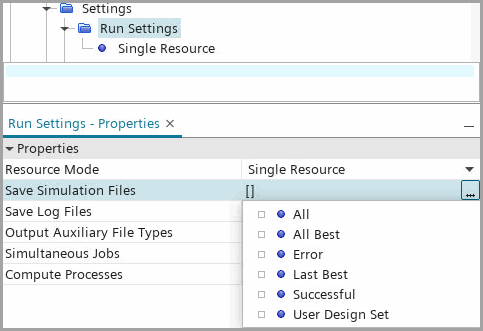Run Settings Reference
The following properties are available for the run settings of a design study in Design Manager.
Run Settings Properties
- Resource Mode
- Specifies one of the following compute resource modes for the design study:
- Single Resource (default)
You select one single compute resource defined within the node. See also Compute Resources .
- Local CAD Update
This option activates the Local CAD Update child node.
A local CAD update consists of two steps—CAD update and successive design runs. The compute resources are specified individually.
- Compute Resource for CAD update
- Specifies the compute resource, which passes the CAD parameters from Design Manager to the native CAD package. This resource must be your local machine on which the native CAD package is installed. Only compute resource type Direct is allowed. By default Default Direct is chosen.
- Compute Resource for successive Design run
- Specifies the compute resource for the remaining steps after the CAD update. Only compute resource type Job Manager is allowed. The Job Manager resource is created under . See also: .
- Single Resource (default)
- Save Simulation Files
- Specifies the design set Simcenter STAR-CCM+ saves during the study.

- []: does not save any *.sim files in the design study. Default option.
- All: saves all the *.sim files in the design study.
- All Best: saves all best designs in the design study. When Design Manager finds a design that is better than any previous design, it saves the corresponding *.sim file.
The best design in a set of designs is the design with the highest performance value (seeEqn. (547)).
- Error: saves the *.sim files for the designs that failed.
- Feasible
: saves the *.sim files that meet all constraints in the design study. Only applicable for design studies with specified constraints. Not available for DOE and CAD Robustness studies.
- Last Best: saves the *.sim file for the last best design that Design Manager finds during the design study run. Only one *.sim is saved with this option. Not available for Pareto Optimization study.
- Successful: saves the *.sim files that ran successfully. The successful designs are all the designs except the Error designs.
- User Design Set: saves the *.sim files filtered in the user design set. See User Design Set.
- Save Log files
- Controls whether to save log files to the design directories. This option is enabled by default for newly created studies.
- Output Auxiliary File Types
- Specifies the extensions of simulation output files to be preserved for each design. Example: [png, csv, jpg, sce, simh]
- Simultaneous Jobs
- Specifies how many design simulations are run at the same time. When running an Optimization study, this value must not be greater than the value specified in Designs to Run divided by 10. If computational and license resources permit, set this value to 1/5 to 1/7 of the value set in Designs to Run.
- Compute Processes
- Specifies how many cores to run with each Simcenter STAR-CCM+ design simulation.
- Design Reuse
- When activated, Design Manager initializes new designs using the results from previous successful
designs. Specifically, it initializes a new design using the closest successful design
in the design space.
The reuse is applicable only when the following criteria are fulfilled:
- The design study is either Sweep, DOE, Adaptive Sampling, or Optimization.
- Design Manager first calculates the
input parameter distance between the new design and all successful designs and
then normalizes the parameter distance by the Global Maximum Distance. The Global
Maximum Distance is the Euclidean Distance of the minimum and maximum values of
all the input parameters of the design:
.
From all the calculated normalized distances, the smallest value is compared with the Maximum Normalized Distance that you specify on the node. If smaller, Design Manager uses the result for the initialization of the new design.
If none of the successful designs has a distance smaller than the Maximum Normalized Distance, Design Manager does not initialize the new design.
If a new design has the same normalized parameter distance of more than one design, the successful design with a larger design number is reused for initialization.
This option is not applicable for studies with Surrogates as Evaluation Method.
- Clear History
- Clears the solution history of each design regardless of the specified Design Reuse option. When activated, no computational history appears in any plots.
This option is not available for the CAD Robustness design study and design studies with Surrogates as Evaluation Method.